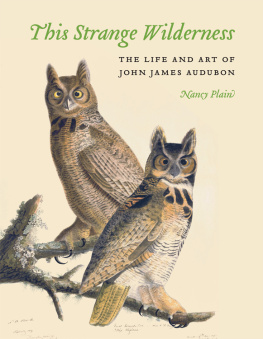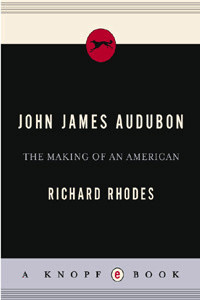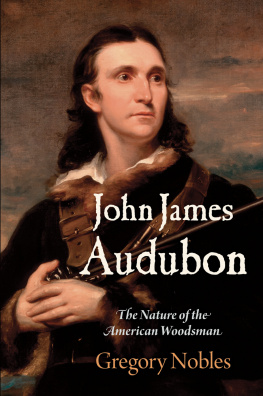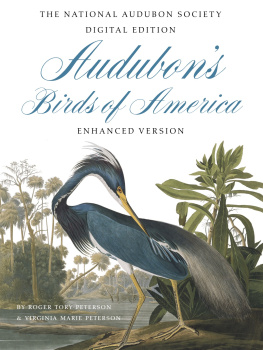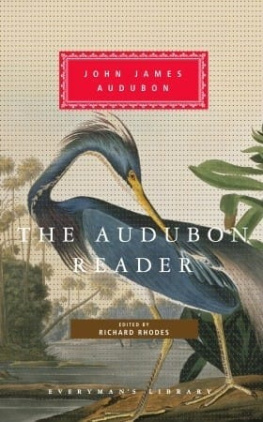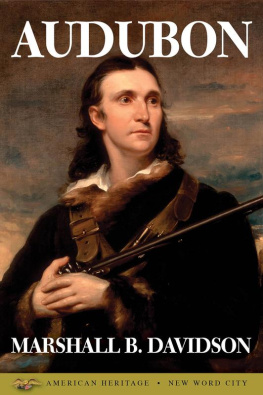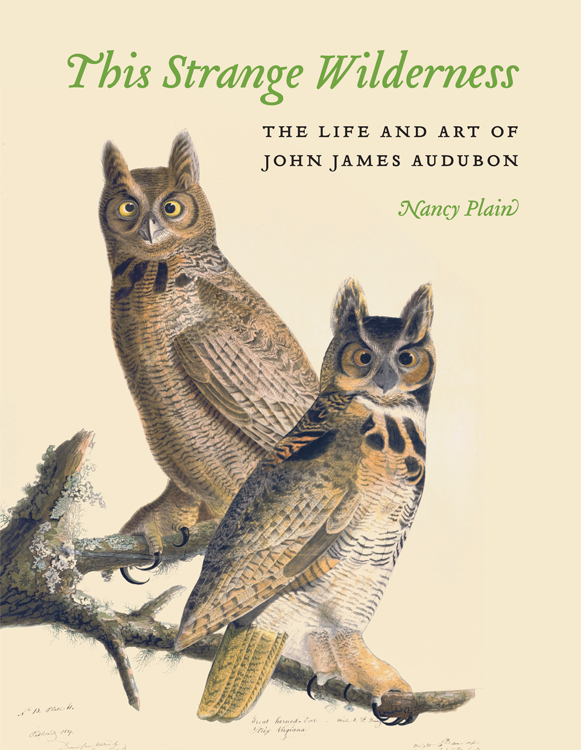
This Strange Wilderness is like walking through a secret door into early nineteenth-century America. Nancy Plains stellar prose and meticulous research, combined with the glorious paintings of John James Audubon, will delight readers of all ages.
Candace Simar, author of the Spur Awardwinning Abercrombie Trail series
Nancy Plain captures the essence of Audubon in words as beautiful and informative as his paintings.
Rod Miller, author of John Muir: Magnificent Tramp
This Strange Wilderness
This Strange Wilderness
The Life and Art of John James Audubon
Nancy Plain
University of Nebraska Press | Lincoln & London
2015 by the Board of Regents of the University of Nebraska
Author photo by Misty Winter
All rights reserved
Publication of this volume was assisted by a grant from the Friends of the University of Nebraska Press.
Library of Congress Cataloging-in-Publication Data
Plain, Nancy.
This strange wilderness: the life and art of John James Audubon / Nancy Plain.
pages cm
Includes bibliographical references and index.
ISBN 978-0-8032-4884-7 (pbk.: alk. paper)
ISBN 978-0-8032-8401-2 (epub)
ISBN 978-0-8032-8402-9 (mobi)
ISBN 978-0-8032-8403-6 (pdf)
1. Audubon, John James, 17851851. 2. OrnithologistsUnited StatesBiography. 3. NaturalistsUnited StatesBiography. I. Title. II. Title: Life and art of John James Audubon.
QL 31. A 9 P 65 2015 508.092dc23
[B] 2014020552
The publisher does not have any control over and does not assume any responsibility for author or third-party websites or their content.
For my grandchildren
June Rose Evans, Jack Alan Dodge,
and those yet to come,
with a heart as light as a bird on the wing
I often think the woods the only place in which I truly live.
John James Audubon
Contents
Special thanks go to Noah Burg for his generous help with my questions on ornithology and to Bill Markley for sending me valuable information on the western forts. I would also like to thank the New-York Historical Society for its magnificent and inspiring exhibition of Audubons watercolors. And many thanks go to the following museums and galleries that made this book possible by kindly granting me permission to use images from their collections: the New-York Historical Society; the American Museum of Natural History; the John James Audubon Museum in Henderson, Kentucky; the Museum of Comparative Zoology at Harvard University; the Montana Historical Society; Godel and Company Fine Art in New York, New York; and the Joel Oppenheimer Gallery in Chicago, Illinois.
I have long wanted to write a book about the roving bird artist, so I am grateful beyond words to everyone at the University of Nebraska Press. Alicia Christensen, Tom Swanson, Sabrina Ehmke Sergeant, Rosemary Vestal, Kathryn Owens, Vicki Chamlee, Nathan Putens, and many others at the press have been with me every step of the way.
Drawn From Nature
In the heat of the afternoon, the swamp was drowsy and still. Turtles rested on a fallen log. An alligator lazed by the water. High up in a cypress tree, there was a flash of color as a great blue heron smoothed her feathers and settled back on a mossy branch. Only the mosquitoes were busy, swarming and humming in the heavy air.
A gunshot blasted the stillness. Hundreds of birds burst shrieking from the treetops, flying in every direction. All except the great blue heron. She clung to her branch for a second, then tumbled down dead to the water below. The hunter, John James Audubon, shouldered his gun and waded through the swamp to pick up his prey.
That same afternoon he made a painting of the beautiful bird, capturing her jewel-like colorsblue, black, white, a splash of red. He preferred using live birds as models but almost always drew from freshly killed ones instead. These were the days before photography, and he wanted to get every detail right, down to the smallest feather. My wish to impart truths has been my guide, he wrote, and he signed his pictures Drawn from Nature, by J. J. Audubon.
Ever since he was a boy, he had been curious about birds and often skipped school to sketch them in the countryside near his home. Now he had set out to do what no one had done beforeto paint all the bird species in North America. Many others over the centuries had painted birds. But most of their work seemed stiff and unnatural to Audubon, as if the birds were sitting for their portraits. He thoughtno, he knewthat he could do better.
My Work will be the Work indeed! he declared. And it was. His masterpiece, The Birds of America, was a lifetime in the making. It is a magnificent collection of pictures of almost five hundred speciessome of them discovered by Audubon himselfand when it was published, the world knew him as one of the greatest bird artists who had ever lived.
Audubons birds glow with life. They look real enough to hop off the page and fly away. His paintings not only show how the birds look but also tell a story about how they live. A mockingbird defends its eggs from a rattlesnake, a bald eagle clutches a catfish in its claw, a fat little puffin goes for a swim. The Birds of America is like a magical visit with all the winged creatures in a vast secret garden.
Born in Haiti and raised in France, Audubon had come to America in 1803, when Thomas Jefferson was president. There were only seventeen states in the Union then, so most of the country was to Americans a mysterious wilderness. Every year explorers set out to chart distant rivers and mountains. Audubon became an explorer, too, looking for birds in their natural habitats. My whole mind was ever filled with my passion for rambling, he wrote.floated down rivers, climbed rocks, and crawled into caves. Once while chasing an owl, he nearly drowned in quicksand. Audubon was a naturalist as well as an artist because he studied everything he could about the birds, from the size of their eggs to the speed of their flight. He even tried to understand their emotional lives. Almost every day he wrote letters and detailed field notes, which he later turned into bird biographies and lively tales of the frontier.
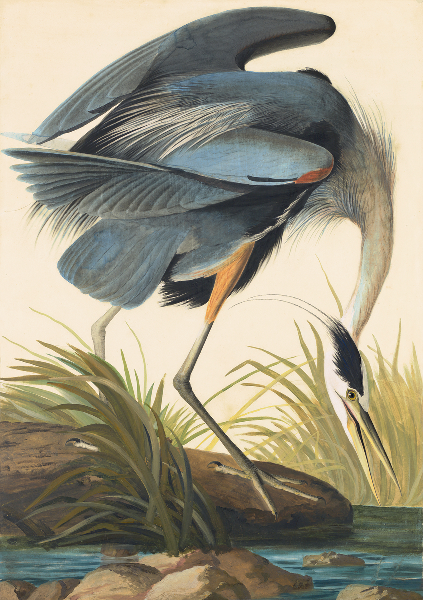
Great Blue Heron by John James Audubon.
Artist. Naturalist. Writer. Hunter and explorer. The far places and the birds called to him. To the end of his life he stayed true to his plan to search out the things which have been hidden since the creation of this wondrous world.
This Strange Wilderness
Beloved Boy
Hot sun and hummingbirds. Orange trees with dark green leaves. These were some of John James Audubons earliest memories. He was born a little French boy named Jean Rabin on April 26, 1785, in Haiti. Haiti, then a French colony called Saint-Domingue, forms a part of the island of Hispaniola, set in the warm Caribbean Sea. Jean never knew his mother, Jeanne Rabin. She had come from France to Saint-Domingue to work as a maid and died a few months after Jean was born. His parents had not been married to each othera fact that he would try to hide all his lifeso he was given his mothers last name.
The boys father, Jean Audubon, was a French sea captain who owned a large sugar plantation on the island. He also bought and sold African slaves. But enslaved Africans far outnumbered white landowners, and during the 1780s, rumblings of an uprising against the brutal system were growing louder every day. So Jean Audubon brought his son and a daughter, Rose, back to his home base in France. There they would be raised by his wife, Anne, who had no children of her own.
Next page
